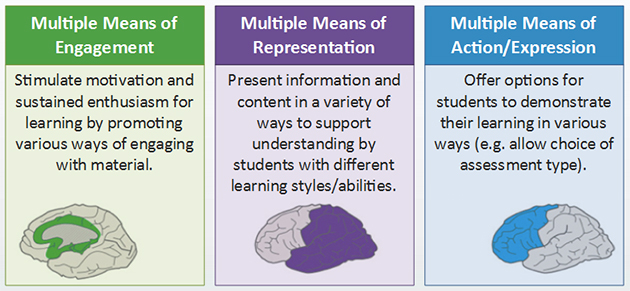One of our school’s initiatives and undertaking this year is to implement a more Universal Design for Learning (UDL) approach for the teacher’s instruction. This initiative paired with this course’s research into implementing mobile technologies into learning environments could not have come at a better time. During the span of work time for this lesson, our school hosted a presenter on an inservice day for topic of UDL. I was, of course enamoured. The speaker’s presentation and the nudge from the workplace got me researching about UDL. One of my main takeaways from researching and the presentation, is that technology integration is the crux of successful UDL implementation.
In the book, “Universal Design for Learning in the Classroom,” the authors make mention of technology’s integration as early as page 6. While first urging moving away from static print sources, the article goes on to mention “UDL, on the other hand, calls for taking advantage of the power and customizability of modern technology to deliver, by design, flexible instructional practices directly within the core instructional curriculum where students can access them on an individualized basis” (Hall et. al, pg 6). The book goes on to say this on page 11: “What role does technology play in applying the UDL Guidelines? Technology gives us many opportunities to customize education to meet individual needs.” We know that no two learners are the same, yet we provide them with the same static textbook, and everybody gets the same thing. We cannot serve everybody the same black coffee.
The UDL Guidelines break down into 3 core principles for designing learning experiences:

For the full UDL Guidelines breakdown, click HERE .
Utilizing mobile technologies can really make UDL implementation a lot easier with these goals in mind. First, multiple means of engagement take some of the the staticness out of the class. Instead, enhance the same questions from a worksheet into gamified quizzing activity…totally doable with technology’s assistance. Gearing students up with motivational activities they want to do can certainly do wonders for their motivation and will to learn. Multiple means of representation can be achieved by students acquiring the same knowledge through different mediums. Rather than just providing a story article, students should be able to access a read aloud or video regarding the same topic. Again, those static sources don’t have the same capabilities as do the screens abundant in homes and classrooms. Lastly, multiple means of action/expression involves the creation aspect of the final product. Contrary to a static test or quiz throughout a unit of study, technology affordances allow students to become more expressive with how they demonstrate their understanding. Connected and networked devices are absolutely necessary in order to achieve UDL components.
Savvy designers are creating games for classrooms that provide student a rich learning experience for students while also informing teachers of student progress with backend data. Jim Diamond, Principal Investigator for the company Playing with Data, states “Well designed games have the potential to be very strong learning environments.” Classroom gameplay on the computer isn’t playing computer games for the sake of playing computer games. Instead, they’re structured and finely crafted to provide teachers meaningful information on the backend. The ability to view the plethora of data on student performance by skill is indispensable for the teacher, and can help them more effectively do their job. In order for teachers to rely on the data, they need a well-thought-out, practical, and easy-to-use dashboard. A simple and effective dashboard tremendously helps teachers find the information to help guide their instruction, provide feedback, and intervene when necessary. Educational gaming goes much deeper than what may originally thought of. Not to mention that a strong gamified platform would hit many UDL aspects.
Strong UDL hinges on the teacher’s intentional use of strategic technologies. Well-designed games can provide teachers with loads of formative assessment data while students feel they’re just playing. I’m quite interested in the educational gaming market, and will keep a close eye on the industry.
References:
CAST (2018). Universal Design for Learning Guidelines version 2.2. Retrieved from http://udlguidelines.cast.org
Hall, T. E., Meyer, A., & Rose, D. H. (2012). Universal design for learning in the classroom: Practical applications. New York: Guilford Press.
